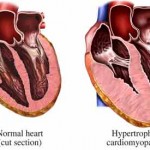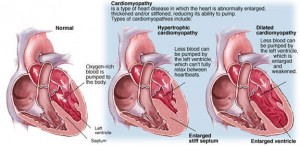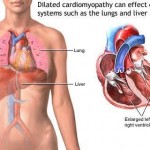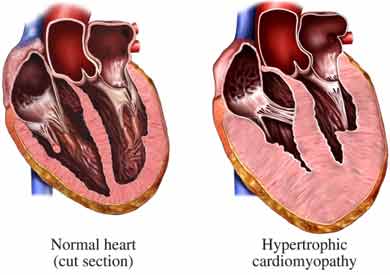Cardiac enlargem rs to an increase in the size of the heart. There are two types of cardiac enlargement: hypertrophy and dilation. (Though usually occurring separately, they may occur at the same time.) Hypertrophy involves an increase in the thickness of the heart muscle. Dilation involves an increase in the size of the inside cavity of a chamber of the heart. Hypertrophy usually occurs in only one chamber while dilation may occur in one, two, three, or all of the chambers, based on its cause. In most cases, cardiac enlargement is abnormal and accompanied by additional cardiovascular problems. The one exception is regular aerobic exercise, which produces a beneficial enlargement involving both hypertrophy and dilation of the heart.
rs to an increase in the size of the heart. There are two types of cardiac enlargement: hypertrophy and dilation. (Though usually occurring separately, they may occur at the same time.) Hypertrophy involves an increase in the thickness of the heart muscle. Dilation involves an increase in the size of the inside cavity of a chamber of the heart. Hypertrophy usually occurs in only one chamber while dilation may occur in one, two, three, or all of the chambers, based on its cause. In most cases, cardiac enlargement is abnormal and accompanied by additional cardiovascular problems. The one exception is regular aerobic exercise, which produces a beneficial enlargement involving both hypertrophy and dilation of the heart.
What causes cardiac hypertrophy?
Hypertrophy, or thickening, of the heart muscle occurs in response to increased stress on the heart. It typically involves one of the bottom chambers of the heart, which are known as the ventricles. The right ventricle pumps blood to the lungs and the left ventricle pumps blood to the body. The most common causes of hypertrophy are related to increased blood pressure in either the lungs or the body. The extra work of pumping blood against the increased pressure causes the ventricle to thicken over time, the same way a body muscle increases in mass in response to weightlifting.
High blood pressure, or hypertension, is the most frequent cause of left ventricular hypertrophy (LVH). Stenosis of the aortic valve – a condition in which, for a variety of reasons, this heart valve cannot open fully – is another common cause of LVH. Hypertrophic cardiomyopathy (a disease previously known as idiopathic hypertrophic subaortic stenosis or IHSS), and the ongoing use of cocaine round out the list of most common causes of LVH. Hypertrophic cardiomyopathy is a genetic disease related to weakness of the individual muscle fibers of the heart. These fibers need to work harder to pump blood and become thickened over time. Hypertrophic cardiomyopathy occurs in 1 in 500 people and is the most common cardiac cause of sudden death in young athletes.
 The most common causes of right ventricle hypertrophy (RVH) are diseases that damage the lung like emphysema and cystic fibrosis. These diseases destroy blood vessels in the lung, causing increased pressure in the remaining vessels. Conditions that decrease oxygen levels, such as chronic bronchitis and sleep apnea, also lead to RVH. Stenosis of the pulmonic heart valve, repeated blood clots to the lungs (chronic pulmonary embolism), and primary pulmonary hypertension are a few of the remaining causes of RVH.
The most common causes of right ventricle hypertrophy (RVH) are diseases that damage the lung like emphysema and cystic fibrosis. These diseases destroy blood vessels in the lung, causing increased pressure in the remaining vessels. Conditions that decrease oxygen levels, such as chronic bronchitis and sleep apnea, also lead to RVH. Stenosis of the pulmonic heart valve, repeated blood clots to the lungs (chronic pulmonary embolism), and primary pulmonary hypertension are a few of the remaining causes of RVH.
What causes cardiac dilation?
The most common causes of dilation are conditions that directly damage the heart muscle. The heart’s healing response is a thinning and stretching-out of the muscle. Types of damage include prior heart attack, long-term alcohol abuse, and heart muscle inflammation. Heart muscle inflammation, or myocarditis, is sometimes of unknown cause and is often associated with a viral infection or interaction between the immune system and the heart muscle. This immune reaction can be seen with inflammatory diseases like lupus or toward the end of pregnancy (approximately 1 in 4000 chance). Other sources of damage to the heart muscle, which can lead to dilatation, include:
- Some types of cancer chemotherapy
- Excess iron accumulation in the body from the disease hemochromatosis
- Cocaine use
- Several of the anti-viral medications used to treat HIV
- Some of the older medications to treat schizophrenia
- Exposure to metals like cobalt, lead, and mercury (an important consideration for those who work in manufacturing processes that includes exposure to these metals)
Cardiac dilation may also be associated with thyroid disease. There is a genetic form of dilated cardiomyopathy, related to many of the several forms of muscular dystrophy; in these, the disease process which affects and weakens body muscle does the same to the heart muscle. Finally, problems with the heart valves can cause abnormal cardiac dilation. In situations where the heart valves cannot fully close, a condition called valvular regurgitation, a backflow of blood with each heartbeat stretches out a chamber of the heart (typically the left atrium or left ventricle), causing it to dilate over time.
What health problems are associated with cardiac enlargement?
 With the exception of exercise-induced enlargement, all forms of cardiac enlargement are abnormal and associated with further problems, including heart failure, irregular heart rhythms , and an increased risk of angina and heart attack. Heart failure results because thickened or dilated heart muscle cannot function effectively as a pump. The diseased muscle cells in both types of enlargement are also capable of causing irregular heart rhythms that can lead to passing-out or sudden death. Because the processes which cause hypertrophy typically do not increase the amount of heart blood vessels to match the thickened heart muscle, the consequences of decreased blood flow to the heart, angina and heart attack, are more common. All of this contributes to an increased risk of death and decreased quality of life for most of those with cardiac enlargement. Treatments are available to help most of these problems.
With the exception of exercise-induced enlargement, all forms of cardiac enlargement are abnormal and associated with further problems, including heart failure, irregular heart rhythms , and an increased risk of angina and heart attack. Heart failure results because thickened or dilated heart muscle cannot function effectively as a pump. The diseased muscle cells in both types of enlargement are also capable of causing irregular heart rhythms that can lead to passing-out or sudden death. Because the processes which cause hypertrophy typically do not increase the amount of heart blood vessels to match the thickened heart muscle, the consequences of decreased blood flow to the heart, angina and heart attack, are more common. All of this contributes to an increased risk of death and decreased quality of life for most of those with cardiac enlargement. Treatments are available to help most of these problems.
